Inside The New York Botanical Garden
red-tailed hawk
Posted in Around the Garden, Photography, Wildlife on January 6 2013, by Patricia Gonzalez
It was a lovely Tuesday morning with cloudless blue skies. I had about an hour and a half before my shift at the NYBG began, so I decided to try my luck spotting a young Red-tailed Hawk that I’d been photographing for weeks. I believe that this is one of the three hawks born earlier this year at the Fordham University nest. His mom is Rose, who I’ve been photographing since 2008. After walking the forest for about an hour, I exited near the Wetlands Trail, where I soon saw my friend. He tried his darnedest to take on a squirrel inside the twisted snag, which resulted in a hilarious game of hawk and mouse with the squirrel living to eat peanuts another day.
I also had an opportunity to shoot a little video of the pair in action, which you can see here.
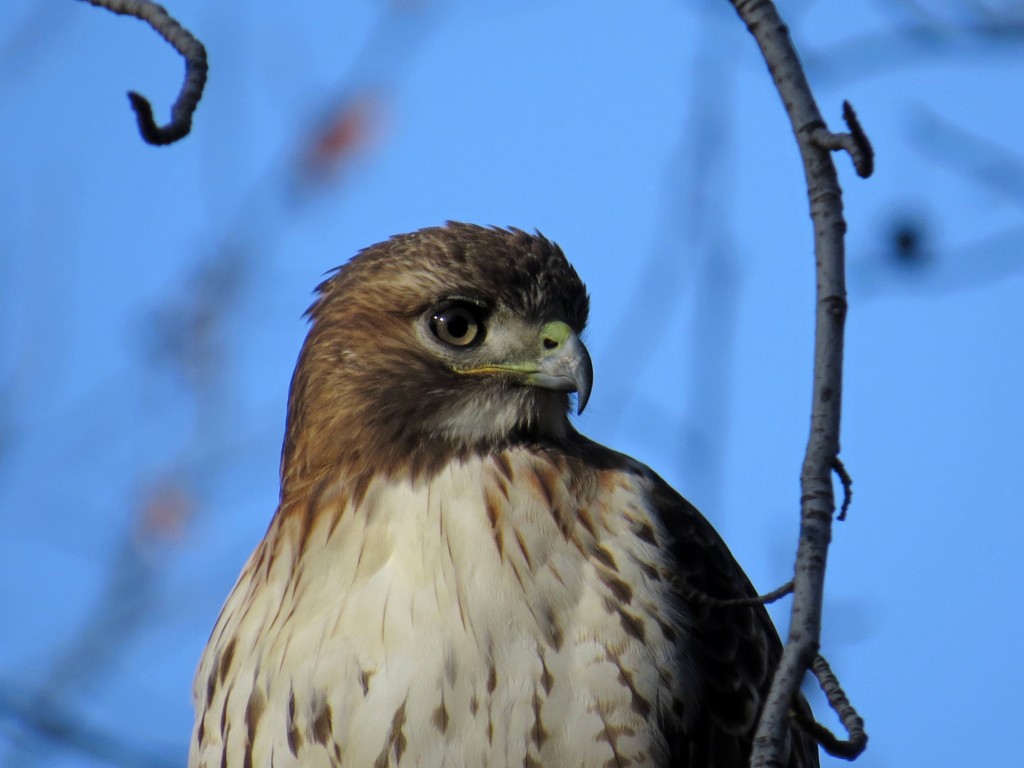
Photo by Patricia Gonzalez
Posted in Around the Garden on August 15 2012, by Patricia Gonzalez
Patricia Gonzalez is an NYBG volunteer and avid wildlife photographer. She can often be found taking photographs around the Garden.
It was a little after noon on February 26 of 2009 that I enjoyed one of the most amazing experiences of my life. By that time, I had already been shooting photographs at The New York Botanical Garden for a year, and it seemed like every creature living in the Garden had cooperated with my camera except for one species: the Red-tailed Hawks which often hunt throughout the NYBG. I had been able to get a few shots, but always from a distance and far overhead.
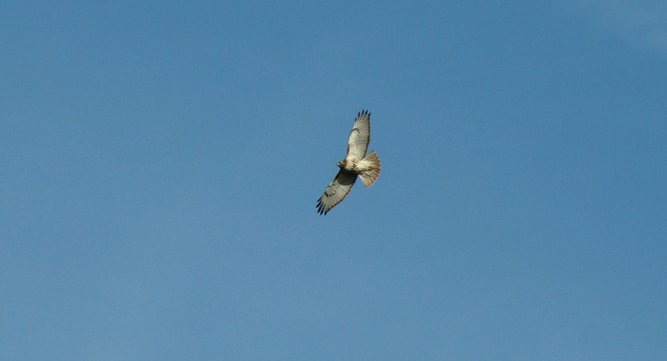
Other times, I couldn’t ready my camera fast enough and my subject matter would disappear into the sky.
Read More
Posted in Around the Garden, Photography, Wildlife on May 31 2012, by Matt Newman
Look to have a bird-brained afternoon as we set aside this beautiful Thursday to celebrate the treetop tweeters of The New York Botanical Garden! We’re flora people, yes, but there’s a majesty (and, at times, comedy) to the diverse fauna of the Garden. Nothing speaks of elegance and grace quite like a juvenile Red-tailed Hawk fumbling its lunch all over Tulip Tree Allée.
If you’re looking to get better acquainted with our feathered friends, stop by on Saturday mornings for the weekly Bird Walk with resident expert Debbie Becker! Binoculars, cameras, and gasps of awe welcome.
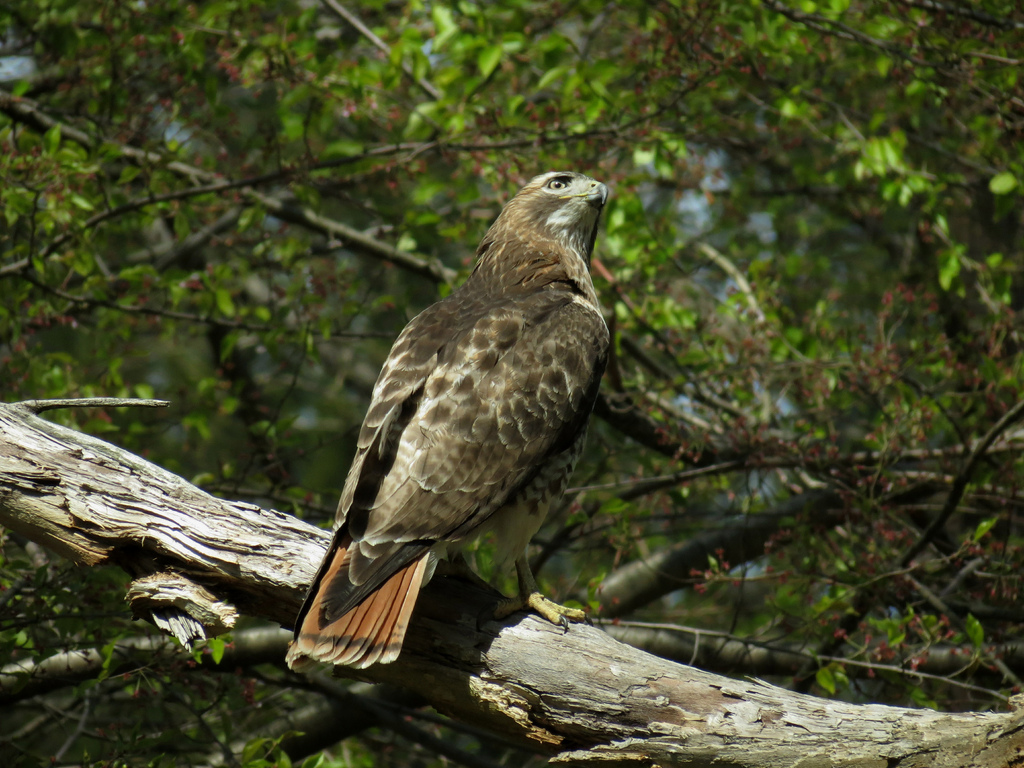
Photo by Pat Gonzalez
Posted in Around the Garden, Photography on January 15 2012, by Matt Newman
Might that be our good friend Junior, 2010’s hatchling of the year? Perhaps local hawk aficionado Pat Gonzalez will chime in with a clarification.
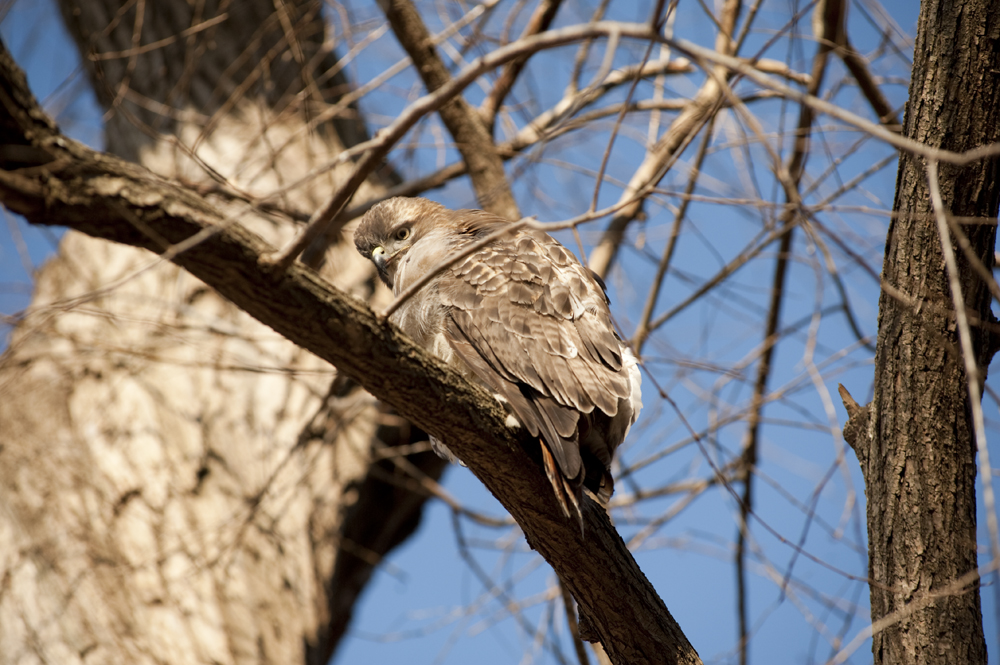
Red-tailed hawk (Buteo jamaicensis) — Photo by Ivo M. Vermeulen
Posted in Members, Wildlife on November 9 2011, by Patricia Gonzalez
Back in February of this year, I related my tale of Rose, the red-tailed hawk who shares a nest on the nearby Fordham University campus with Vince, her mate. Since then, the hawks have extended their family. In May, four chicks (a record for this pair and likely any other Bronx hawks) came out to the world. I knew that it was only a matter of time before these youngsters would pay The New York Botanical Garden a visit. I hoped to be lucky enough to see these raptors close up, and I recently got my wish.
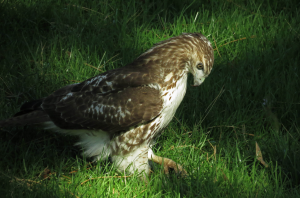 It was 9:40 a.m. on a chilly October morning and I had just passed the Garden’s reflecting pool. I wanted to do some shooting of the Conservatory grounds. That’s when I noticed a hawk darting overhead, landing on the lawn by the first tram stop on Garden Way.
It was 9:40 a.m. on a chilly October morning and I had just passed the Garden’s reflecting pool. I wanted to do some shooting of the Conservatory grounds. That’s when I noticed a hawk darting overhead, landing on the lawn by the first tram stop on Garden Way.
The tram crew hadn’t noticed it at first. The hawk was looking down at something. After watching Jr. (one of this hawk’s siblings from 2010’s brood) for so many months this past winter, I already knew what was going to happen next, so I tip-toed ahead, ducking behind one of the two nearby trees and readying my camera. I set it to shoot eight images in one burst and began firing away. It was windy and the ray of sunlight shining through the trees directly onto my new friend kept changing, making getting clear shots interesting to say the least. But I got photos of the newest member of Rose’s dynasty regardless.
Read More
Posted in Wildlife on February 18 2010, by Plant Talk
Bird Watchers Witness Drama During Weekly Walk
 |
Debbie Becker leads a free bird walk at the Garden every Saturday from 11 a.m. to 12:30 p.m. beginning at the Reflecting Pool in the Leon Levy Visitor Center.
Photo of owls: Debbie Becker
|
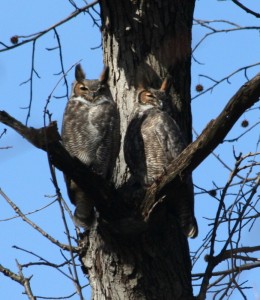 Late last month, in frigid weather conditions, 12 loyal birders met me under the clock at 11 a.m. for the weekly bird walk around the Garden. Our main objective was to see the nesting great horned owls. We headed over to the snag at the Forest’s edge where the owls successfully nested last year, and there in a cavity we saw our resident female owl, all fluffed up sitting, presumably, on eggs—only the top half of her body was visible.
Late last month, in frigid weather conditions, 12 loyal birders met me under the clock at 11 a.m. for the weekly bird walk around the Garden. Our main objective was to see the nesting great horned owls. We headed over to the snag at the Forest’s edge where the owls successfully nested last year, and there in a cavity we saw our resident female owl, all fluffed up sitting, presumably, on eggs—only the top half of her body was visible.
We then searched for the male owl, who usually is nearby, guarding the nest and his mate. Our binoculars scanned the bare branches of surrounding trees until we spotted him wedged between the trunk and a branch of a tree. Three blue jays were harassing him—screeching at the top of their lungs. When one jay got too close, the owl flew to a branch closer to us.
 As we stood there freezing and admiring his majestic beauty a red-tailed hawk flew in and landed about 20 feet away from the owl. This wasn’t any red-tailed hawk—it was the female that nested on the Library building last spring. She and her mate (he later died from eating a poisoned rat) had three offspring; she and her brood often can be seen flying around the Garden searching for prey. We had seen the female many times before, silently perched waiting for some unsuspecting squirrel or rabbit to happen by.
As we stood there freezing and admiring his majestic beauty a red-tailed hawk flew in and landed about 20 feet away from the owl. This wasn’t any red-tailed hawk—it was the female that nested on the Library building last spring. She and her mate (he later died from eating a poisoned rat) had three offspring; she and her brood often can be seen flying around the Garden searching for prey. We had seen the female many times before, silently perched waiting for some unsuspecting squirrel or rabbit to happen by.
Read More
Posted in Wildlife on April 14 2009, by Plant Talk
  |
Wayt Thomas is the Elizabeth G. Britton Curator of Botany in the Institute of Systematic Botany. Stella Sylva is Administrative Curator in the William and Lynda Steere Herbarium. |
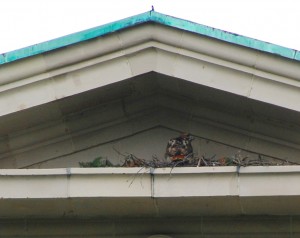 The pair of red-tailed hawks (Buteo jamaicensis) nesting on the Library building appear to be consistently present at the nest although the female is usually not visible when sitting. So, although we cannot say for sure, it is likely that she has laid eggs and is brooding.
The pair of red-tailed hawks (Buteo jamaicensis) nesting on the Library building appear to be consistently present at the nest although the female is usually not visible when sitting. So, although we cannot say for sure, it is likely that she has laid eggs and is brooding.
Their nest is in a small triangular alcove near the top of the front face of the building on the east side (see photos). The close-up photo captures the female stretching her wings and preening herself. Afterward, she went back to the middle of the nest, hunkered down, and disappeared from view. If all goes well, the eggs will hatch sometime this month. We’ll keep you posted when we find out more.
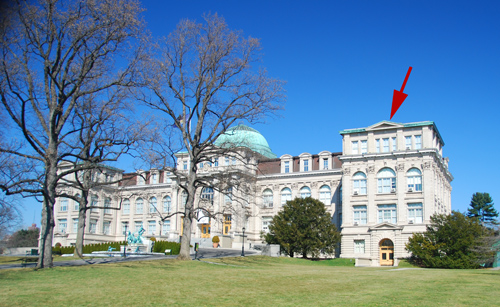
Photos by Wayt Thomas
Posted in Wildlife on March 24 2009, by Plant Talk
  |
Wayt Thomas is the Elizabeth G. Britton Curator of Botany in the Institute of Systematic Botany. Stella Sylva is Administrative Curator in the William and Lynda Steere Herbarium. |
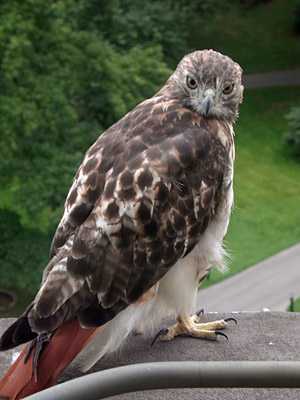
Photo by Tony KirchgessnerFor the past several weeks a pair of red-tailed hawks (Buteo jamaicensis) has been building a nest on the Library building. Their nest is in a small triangular alcove near the top of the front face of the building on the east side (see photos)—they swoop by our office windows on their way to and from the nest.
Last year they started building a nest here but changed their mind and went elsewhere—Fordham University, according to Debbie Becker, who leads the Saturday morning bird walks at the Botanical Garden. This year the hawks seem to be serious. Two weeks ago they were engaged in a very active courtship display and mated several times a day.
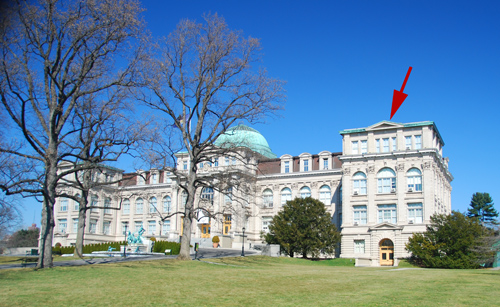
Photo by Wayt ThomasRed-tailed hawk pairs are monogamous, with females (2–4.5 lbs.) larger than males (1.5–3 lbs). The adults have a dark brown back with a pale underbelly and a darker band across the belly; the tail is brick-red above and pinkish below. Our pair is unusual in that they are accompanied by a third hawk—rarely, a second female may help tend the nest and feed the young. This immature bird is an offspring of the pair’s from last year. If everything proceeds according to what we know about these hawks, 1 to 3 eggs will be laid in late March or April—we’ll keep you posted.
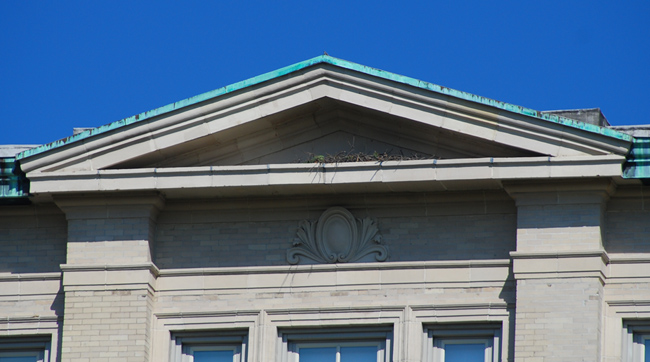
Photo by Wayt ThomasRed-tailed hawks usually feed on small mammals or birds and their preferred habitat is a mix of forest and open areas, such as we have here on the Garden grounds. Their diet consists primarily of squirrels, pigeons, small birds, and rabbits. We don’t know if they are part of the Garden’s Integrated Pest Management plan, but there are fewer squirrels than usual in front of the Library building.











 The
The 


